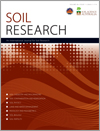The actions of the multitude of organisms that live in the soil are crucial to the survival and growth of all plants and animals. In addition to environmental factors such as temperature, soil use, and management influence the diversity and activities of soil organisms. Despite extensive research, our understanding of how soil biodiversity influences plant and animal production in agricultural and forest systems has been limited due the complex nature of interactions between the different types of organisms.
SR19067 Abstract | SR19067 Full Text | SR19067PDF (935 KB) Open Access Article





